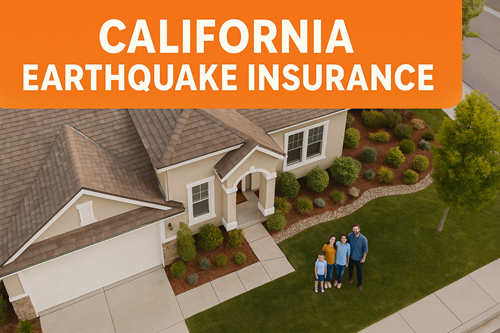
California Earthquake Insurance: How much does California earthquake insurance cost? What does California earthquake insurance cover? Is California earthquake insurance worth it?
By Sun Insurance & Financial
📍 Serving Los Angeles | Beverly Hills | Santa Monica | Malibu | West Hollywood | Statewide in California
🌐 SunInsurance.us
☎ (310) 860-5000
📘 Table of Contents
- Introduction: Why California Needs Earthquake Insurance
- What Is California Earthquake Insurance?
- What Does Earthquake Insurance Cover?
- What’s Not Covered
- How California Earthquake Policies Work
- Pros & Cons of Earthquake Insurance
- Example: Real-World California Earthquake Loss
- Risk Map: California Fault Zones
- Cost Table: Earthquake Insurance Premium Comparison
- Frequently Asked Questions (Q&A)
- How to Buy Earthquake Insurance
- Why Choose Sun Insurance & Financial
- Contact Us
🌋 Introduction: Why California Needs Earthquake Insurance

California Earthquake Insurance: California lies on over 15,000 known fault lines, including the San Andreas, Hayward, and San Jacinto Faults.
More than 70% of Californians live within 30 miles of an active fault — making earthquake insurance a financial necessity, not a luxury.
Despite the risk, only ~12% of homeowners carry earthquake insurance. Many mistakenly believe their homeowner’s or FAIR Plan policy includes quake coverage — but it does not.
A single 7.0 magnitude quake could cause over $300 billion in damage statewide. Without proper coverage, families may lose both their home and life savings.
🏠 What Is California Earthquake Insurance?

California Earthquake Insurance provides protection against earth movement, covering structural and personal property losses caused by seismic activity.
It’s regulated by the California Earthquake Authority (CEA) and sold through private insurers.
The CEA currently protects over 1.1 million homes statewide.
| Feature | Description |
|---|---|
| Provider | California Earthquake Authority (CEA) & private insurers |
| Eligibility | Must hold an active CA homeowners, condo, or renters policy |
| Coverage Focus | Ground shaking, structural collapse, cracked foundations, interior damage |
| Deductibles | 5%–25% of dwelling coverage |
| Optional Add-ons | Personal property, loss-of-use, and building code upgrades |
🧱 What Does California Earthquake Insurance Cover?

California Earthquake Insurance covers physical damage directly caused by earth movement.
🏗️ Core Coverages
| Coverage Type | What It Protects | Example |
|---|---|---|
| Dwelling Coverage | Structure of your home | Foundation cracks, collapsed walls |
| Personal Property | Furniture, electronics, appliances | Broken TVs, damaged furniture |
| Loss of Use / ALE | Temporary living costs | Hotel & meal expenses |
| Building Code Upgrade | Brings repairs up to new seismic codes | Bolting, retrofitting, foundation bracing |
| Detached Structures | Garages, sheds, or guest houses | Cracked garage foundation |
💡 CEA policies can be customized by deductible and personal property limits.
🚫 What’s Not Covered

Even with a California Earthquake Insurance policy, certain losses remain excluded:
| Excluded Risk | Alternative Coverage |
|---|---|
| Fire following earthquake | Standard homeowner’s insurance |
| Tsunami or flood | FEMA or private flood policy |
| Landslides or sinkholes | Specialty earth-movement policy |
| Vehicles | Comprehensive auto insurance |
| Landscaping | Not covered |
| Pre-existing structural cracks | Must be repaired before purchase |
⚙️ How California Earthquake Insurance Policies Work

When you buy California Earthquake Insurance, it’s usually an add-on to your homeowners or FAIR Plan policy.
You choose your:
- Coverage limit (matches your dwelling value)
- Deductible (5%, 10%, 15%, 20%, or 25%)
- Optional coverages (personal property, ALE, building code)
Example
| Home Value | Deductible | Damage | Payout |
|---|---|---|---|
| $600,000 | 10% ($60,000) | $180,000 | $120,000 payout |
⚖️ Pros & Cons of California Earthquake Insurance
✅ Pros
- Protects equity in your home after seismic damage
- Meets lender requirements in high-risk areas
- Covers loss of use for temporary housing
- Customizable deductibles for affordability
- Backed by CEA’s $20+ billion reserve
❌ Cons
- High deductibles (10–25%)
- Limited personal-property protection
- Separate purchase required
- No coverage for fires or floods caused by quakes
🧩 Example: Real-World California Earthquake Insurance Loss

🧮 Case: 1994 Northridge Earthquake (Magnitude 6.7)
| Impact | Statistic |
|---|---|
| Homes Damaged | 60,000+ |
| Total Loss | $44 billion |
| Uninsured Homeowners | ~85% |
| Typical Home Damage | $200,000–$500,000 |
Homeowners with earthquake insurance rebuilt within months. Those without coverage faced years of debt.
🌍 Risk Map: California Fault Zones
California Earthquake Risk by Region (2025)
| Region | Primary Faults | Risk Level |
|---|---|---|
| Los Angeles & Ventura | San Andreas, Puente Hills | 🔴 Very High |
| San Francisco Bay Area | Hayward, Calaveras, San Andreas | 🔴 Very High |
| Sacramento Valley | Midland, Dunnigan Hills | 🟠 Moderate |
| San Diego County | Rose Canyon, Elsinore | 🟠 Moderate |
| Inland Empire | San Jacinto, Elsinore | 🔴 Very High |
| Central Coast | Hosgri, Rinconada | 🟡 Elevated |
| Northern California | Maacama, Mendocino | 🟡 Elevated |
💰 Cost Table: Earthquake Insurance Premium Comparison

| City | Average Home Value | 10% Deductible Annual Premium | 20% Deductible Annual Premium |
|---|---|---|---|
| Los Angeles | $1,000,000 | $2,100 | $1,500 |
| Beverly Hills | $2,000,000 | $3,800 | $2,900 |
| Santa Monica | $1,500,000 | $3,200 | $2,400 |
| Malibu | $2,500,000 | $4,500 | $3,200 |
| San Francisco | $1,400,000 | $3,000 | $2,100 |
| Sacramento | $700,000 | $1,000 | $750 |
📊 Rates vary by construction type, retrofitting, and proximity to fault lines.
💬 Frequently Asked Questions (Q&A)
Q1. Does my homeowners policy cover earthquakes?
No. You need a separate California Earthquake Insurance policy.
Q2. Who offers earthquake coverage?
The California Earthquake Authority (CEA) and licensed private insurers like Sun Insurance & Financial.
Q3. How much does earthquake insurance cost?
Typically between $800 – $2,500 per year, depending on home value and deductible.
Q4. What if I rent my home?
You can buy a renters earthquake policy covering your belongings and living expenses.
Q5. Can I combine earthquake insurance with the FAIR Plan?
Yes. Sun Insurance helps clients combine California FAIR Plan (fire coverage) with private earthquake insurance for full protection.
Q6. Is retrofitting worth it?
Yes. Homes with bolted foundations can receive up to 20% premium discounts.
Q7. Are condos covered?
Yes, both unit owners and associations can purchase coverage for common areas and interior improvements.
📊 Historical Loss Graph: California Earthquakes by Year

| Year | Major Earthquake | Estimated Damage ($ Billions) |
|------|------------------|-------------------------------|
| 1971 | San Fernando | 0.6 |
| 1989 | Loma Prieta | 6.0 |
| 1994 | Northridge | 44.0 |
| 2014 | Napa | 0.7 |
| 2019 | Ridgecrest | 1.0 |
| 2025 (projected risk) | - | 70.0+ |
🔍 Modern building codes have reduced fatalities, but property losses continue to climb.
🧮 Example of Deductible Impact
| Home Rebuild Value | Deductible | Out-of-Pocket Cost | Payout (Damage = $250k) |
|---|---|---|---|
| $500,000 | 5% | $25,000 | $225,000 |
| $500,000 | 10% | $50,000 | $200,000 |
| $500,000 | 20% | $100,000 | $150,000 |
Choosing a higher deductible can lower your premium but increases personal exposure.
🏠 Example 1: Cracked Foundation and Walls
Scenario:
A 6.5-magnitude earthquake shakes Los Angeles. A homeowner’s concrete foundation cracks, and large fissures appear in the living room walls.Insurance Payment:
- Covered: Structural damage to the foundation and walls.
- Payout Example:
- Structural repairs: $85,000
- Deductible (10% of dwelling limit, say $60,000): –$60,000
- Insurance pays: $25,000
Note: Homeowners pay the deductible first, and the insurer covers the rest up to the dwelling limit.
🪟 Example 2: Broken Windows and Damaged Roof
Scenario:
In Santa Monica, tremors cause a tile roof to collapse and shatter windows throughout the house.Insurance Payment:
- Covered: Roof repair, replacement of windows, cleanup costs.
- Not Covered: Cosmetic cracks with no structural risk.
- Insurance pays: Around $40,000 after the deductible.
🛋️ Example 3: Interior Damage and Personal Belongings
Scenario:
An earthquake in Beverly Hills shakes a home violently—TVs, furniture, and valuables fall and break.Insurance Payment:
- Covered: Personal property damaged by earthquake motion.
- Example Payout:
- Furniture replacement: $12,000
- Electronics: $8,000
- Total claim: $20,000 (after $5,000 deductible)
🚪 Example 4: Loss of Use (Temporary Housing)

Scenario:
A Malibu home becomes uninhabitable after an earthquake damages the foundation. The family must rent a temporary apartment for 3 months.Insurance Payment:
- Covered: Additional living expenses (hotel, meals, rent).
- Example Payout:
- Temporary housing: $9,000
- Food and transportation: $2,000
- Total: $11,000
🏢 Example 5: Condo Owner (HO-6 Earthquake Endorsement)
Scenario:
A condo building in San Francisco sustains structural damage, and the HOA’s master policy covers exterior repairs—but interior walls and floors inside the unit are damaged.Insurance Payment:
- Covered: Interior drywall, flooring, cabinets.
- Example Payout: $15,000 after the individual deductible.
🏗️ How to Buy California Earthquake Insurance
- Review Your Homeowners Policy.
Check if your insurer offers a CEA policy or private equivalent. - Contact Sun Insurance & Financial.
Our agents compare rates, limits, and deductible options. - Select Deductible & Coverage.
Choose between 5%–25% deductibles and optional add-ons. - Retrofit for Discounts.
Foundation bolting, chimney bracing, and cripple-wall shear can save up to 25%. - Bind and Activate.
Policies generally take effect 15 days after purchase.
🌐 Apply easily at SunInsurance.us or call (310) 860-5000.
🌞 Why Choose Sun Insurance & Financial

Sun Insurance & Financial is California’s trusted local expert for home, business, and earthquake insurance solutions.
🌟 Our Advantages
✅ Independent agency — we compare multiple insurers
✅ Licensed throughout California
✅ Experts in FAIR Plan + California Earthquake Insurance coverage combos
✅ Personalized protection plans for luxury and coastal homes
✅ Fast claims support after seismic events
🏡 Serving Los Angeles, Beverly Hills, Malibu, Santa Monica, and all of California.
📞 Contact Us
Sun Insurance & Financial
🌐 www.SunInsurance.us
📍 Beverly Hills, California
☎ (310) 860-5000
📧 info@suninsurance.us
Protect your home and family before the next earthquake strikes.
Call or visit SunInsurance.us for a free California Earthquake Insurance quote today.
🔑 SEO Keywords

California Earthquake Insurance, Earthquake Insurance California, Earthquake Coverage, California Seismic Insurance, California Earthquake Authority, CEA Insurance, Los Angeles Earthquake Coverage, Beverly Hills Earthquake Insurance, Malibu Home Insurance, California FAIR Plan Earthquake, High-Risk Home Insurance, Seismic Retrofit Discounts
📢 Hashtags
#CaliforniaEarthquakeInsurance #SeismicProtection #SunInsurance #LosAngelesInsurance #MalibuInsurance #CaliforniaHomeowners #EarthquakeCoverage #CEAInsurance #BeverlyHillsHomes #SantaMonicaInsurance
🏡 Protect your home before the next quake hits. Call Sun Insurance & Financial today for your California Earthquake Insurance quote.
🔑 Keywords
California Earthquake Insurance, Earthquake Coverage California, California Earthquake Authority, CEA Insurance, High-Risk Home Insurance, Earthquake Policy California, Los Angeles Earthquake Insurance, Malibu Home Insurance, Santa Monica Earthquake Protection, California Seismic Coverage, Earthquake Damage Protection, Earthquake Home Insurance California
📢 Hashtags

#CaliforniaEarthquakeInsurance #EarthquakeCoverage #SeismicProtection #LosAngelesInsurance #MalibuInsurance #SunInsurance #CaliforniaHomeowners #CEAInsurance #BeverlyHillsInsurance #SantaMonicaHomes
📞 Contact Us
Sun Insurance & Financial
🌐 www.SunInsurance.us
📍 Serving All of California
☎ (310) 860-5000
📧 info@suninsurance.us
Sun Insurance and Financial https://SunInsurance.us
Travelers Insurance
The Hartford Insurance
California Fair Plan Insurance
Hiscox Insurance
Lloyds
Foremost Insurance
Progressive Insurance
California Earthquake Authority
